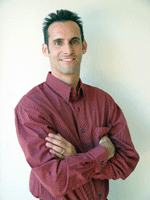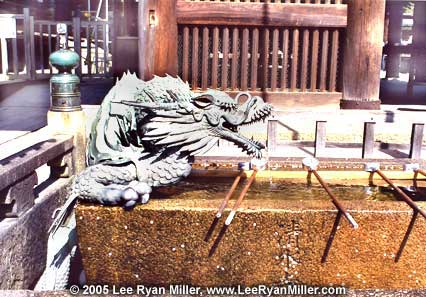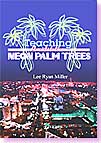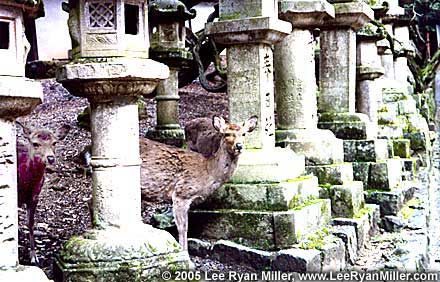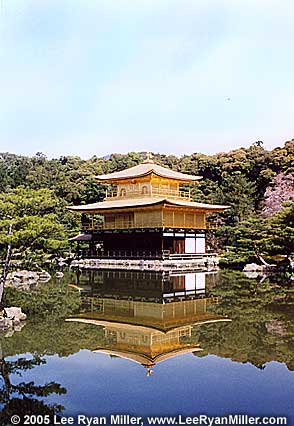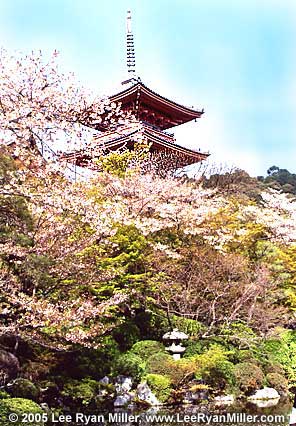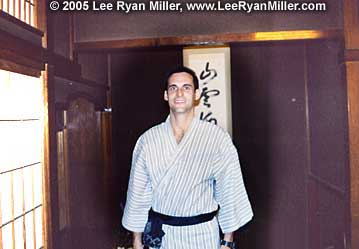|
|
Lee's Adventures on Semester at Sea ® OSAKA,
JAPAN
|
||
|
Introduction
|
Afterwards, we visited the mosque. Inside, we took off our shoes. No one else was there besides us and the immam. By tradition, men and women are separated in a mosque. Arif showed Bryan and me how to wash: hands and forearms, feet, face, etc. Then Arif said his prayers on the mat in the prayer room. His prayers consisted of reciting verses from the Koran in Arabic. It
was an interesting juxtaposition, visiting the shrine and the mosque. Afterwards,
we returned to Osaka.
We visited the Mint Bureau gardens to view the cherry blossoms. It
seemed peculiar to view cherry blossoms at night.
But they were lit up, and hundreds of other people were there for
the same reason. The
blossoms were beautiful.
I had no idea that there were so many varieties.
They varied in color from white to pink to red, and from the size
of pennies to the size of carnations.
Nearby there were stalls selling food, like corn on the cob and
chunks of octopus fried in batter.
I had some of the corn. Two
night’s earlier, when Hiroko and Mariko had explained at the cultural
pre-port meeting that Japanese were fond of eating “octopus balls,”
everyone had bust out laughing.
The young women were perplexed by this reaction.
This evening at the cherry blossom festival, I explained to them
that the students had laughed because they’d thought that Japanese ate
octopus testicles.
The young women found this very funny. The
next morning, I left for an overnight trip to Nara and Kyoto.
I was not enthusiastic about going on this trip.
I had scheduled it specifically because Beth had wanted to take a
trip with an overnight stay in a Ryokan, a traditional Japanese style inn.
Beth had been unable to join the voyage, after our itinerary
change, and I was not very enthusiastic about making this trip without
her. It
turned out, however, that this was a wonderful trip. The
drive to Nara took about 90 minutes.
Nancy Henry sat next to me.
She is an elderly lady from Virginia.
She talks nonstop.
She told me everything you can imagine, from her childhood on a
plantation, to her unhappy marriage and divorce, to her life traveling the
world, living off her fortune.
Eventually, I told her I was tired, and I took a nap. We
spent the first day in Nara, the first capital of Japan (in the 8th
century, I think).
Upon arrival, we visited the Horyuji Temple, which is the oldest
wooden structure in the world.
It is over 1300 years old.
Japanese Buddhist temples are made of wood, as are Korean ones.
All other wooden temples of that age have burned down over the
centuries, but this one somehow has survived. We
had lunch at a restaurant.
It was sort of Japanese-style Western food.
There were little sandwiches with the crust cut off, salad, with
soy/sesame dressing, etc.
The restaurant overlooked a beautiful Japanese garden.
Japanese gardens, unlike Western gardens, tend to be hilly,
incorporating streams, waterfalls, boulders, etc.
They have a very natural feel to them, but they are still carefully
manicured.
It is sort of a stylized depiction of nature, as opposed to a
Western garden, which tends to be more an arrangement of plants and
flowers without trying to emulate nature.
I think the Japanese style has something to do with Shinto, the
traditional religion that focuses on reverence for nature.
After
lunch, we walked across a large park full of deer.
The deer were very tame.
You could pet them and feed them crackers that were on sale from
various venders.
One deer tried nibbling on the back pocket of my jeans.
It tickled. At
the far side of the park was the Todaiji Temple.
It was built in the 700s, and houses a huge bronze Buddha.
Inside the temple there is a wooden pillar with a rectangular hole
carved in it. The
hole is just big enough for a slim person to crawl through.
Legend has it that people who crawl through the hole go directly to
paradise after this life, rather than having to be reincarnated.
At the encouragement of my students, I crawled through. I
had to go through diagonally, rather than face down, so that my shoulders
would fit.
A student on the other side helped to pull me through, while
another took a picture of me. Afterwards,
we visited the Kasuga Shrine.
Like many Shinto shrines, you had to climb up a hill, crossing
through a couple of torii gates.
The path was lined by little stone pagodas.
Moss clung to the pagodas, and deer wandered freely.
It was very pretty. We
boarded our tour bus and drove to our ryokan in Kyoto.
A ryokan is a traditional Japanese inn.
I shared a room with Marci and Jim.
Both are psychologists.
Marci is the assistant counselor on the ship, and her husband Jim
(who is retired) accompanied her on the voyage. Our
room was very beautiful.
We had two 8-tatami rooms (tatami mats are about three by six
feet), a private bathroom, and a beautiful garden just outside our
windows.
By tradition, in a ryokan you take off your street clothes and wear
a yukata (Japanese cotton robe) and slippers, which are provided by the
establishment. We
had a nice sukiyaki dinner (the meat was excluded for the vegetarians).
My roommates and I, plus a few others, took a cab to the Gion
district, where the geisha work.
We went to a show demonstrating some traditional Japanese art
forms: tea
ceremony, koto (Japanese harp) performance, flower arrangement, gagaku (a
style of traditional music and dance traditionally performed at court
banquets), Kyogen (ancient comic play performed as an interlude for Noh
plays), Kyomai (traditional dance), and Bunraku (puppet performance).
The music was lovely, and the costumes beautiful.
The puppet performance was characterized by extraordinarily
lifelike movements.
The puppet was not manipulated by strings, as in the Western
tradition.
Instead, 3 men dressed all in black moved the large puppet by hand.
I was amazed at how effectively they coordinated their movements. The
performance lasted about an hour.
Afterwards, we walked around Gion.
Our guide had advised us that there were only about 75 women
working as geisha and apprentice geisha; she said that it was unlikely
that we would see any.
If this is true, we were extraordinarily lucky.
We saw four during our stroll around Gion.
They were very graceful and beautiful. Before
bed that night, I soaked in the big communal bath down the hall, as is
traditional in a ryokan.
I was extremely relaxed afterwards, and fell right to sleep.
In
the morning, we had a traditional Japanese breakfast (miso soup, rice,
fish, vegetables, etc.) and then set off to explore Kyoto.
We visited the Rokuon-ji temple, with its famous “golden
pavilion,” a large pagoda covered with gold leaf jutting out into a
tranquil lake.
It was beautiful, as were the gardens.
We
also went to Nijo castle, the castle that was used by the Shogun when he
visited Kyoto.
Like other Japanese castles, it was constructed of wood, and was
protected by a high stone wall.
But it had some very interesting security features.
The floor was designed to squeak when one walked upon it (the sound
likened to a nightingale), so that it would be hard for assassins to sneak
in during the night.
Also, the audience rooms all had a door leading to a room where the
shogun’s guards hid, just in case there was a problem.
Visiting samurai were forced to turn in their long swords (they
were permitted to keep their short swords), and were required to wear
extra long pants.
If they tried to kill the shogun, they would trip over the pant
legs and would have a hard time running away. The
gardens had wonderful cherry blossoms.
We were very fortunate that the cherry blossoms were in bloom
during our port calls in Nagasaki, Pusan, and Osaka. We
enjoyed a wonderful lunch at the Restaurant Ganko Takasegawa Nijoen.
It was located in the former home of a prominent politician.
It was beautifully decorated in traditional Japanese style, and had
a lovely garden.
Lunch was a huge feast of tempura and shabu-shabu – tofu,
vegetables, and meats that you cook on the table in your own bubbling
paper pot set above a little candle.
Unique to Kyoto, the pot was full of boiling soy milk. After
lunch we visited the Sangju-Sangen-Do Temple.
This temple had a large hall housing 1001 golden statues of the
Buddhist deity Kannon.
The statues are arrayed on bleachers, such that the ones in the
back are higher than the ones in the front.
These legions of multi-armed goddesses of mercy were guarded by
some thirty other statues arrayed in front.
The effect was breathtaking. This
temple was also famous for an annual archery tournament for samurai.
Nowadays, there are no samurai, and common people compete.
Our
last stop was the Kiyomizu temple complex.
We visited a series of temples and pagodas on a hill, with
beautiful gardens in the canyon down below.
There was also a spring from which issues what is reputed to be one
of the ten best-tasting waters in Japan.
The water drops in four small waterfalls down into a pool below.
People line up to catch the stream in tin cups with long handles.
After drinking, people place the cups in a device that sterilizes
them with ultraviolet light so that the next person can use them. While
I was standing in line to try the water, a group of old ladies elbowed me
aside and cut in front of me.
I later told our guide about the experience, and she said that
people in Japan sometimes talk disdainfully about the “rude oba-san.”
As
for the water, it tasted good, but I’m not entirely sure what all the
hoopla was about.
Perhaps one needs to be Japanese to fully understand. The
following day, I went with Sheila (the elderly English professor with the
cabin next to mine) to check my e-mail.
Sheila had located a free Internet café near the Umeda station.
We ran into Deborah, one of the post-grads (the name given to
passengers who are not faculty nor staff nor family nor students) and had
lunch. Sheila
was not feeling well (she was later diagnosed with pneumonia—poor thing)
and Deborah and I went to explore Osaka Castle. The
castle grounds are an enormous park in the center of the city.
The castle is surrounded by a water-filled moat, followed by a high
stone wall, followed by a dry moat, followed by another stone wall.
The castle itself was destroyed in various wars, and was rebuilt in
the1970s.
It is very pretty from the outside.
The inside is a museum devoted to the history of the castle. That
history is quite interesting.
It was built by Toyotomi, a rival of Tokugawa Ieyasu, the nobleman
who united Japan and became the first shogun in the 1600s.
Toyotomi was never defeated by Tokugawa, and it was not until after
his death that the shogun was able to subdue his clan. The
next day, my final day in Japan, I visited the aquarium next to the
location where our ship was docked.
It was the most beautiful aquarium that I have ever visited.
I liked it better than the Monterey Bay Aquarium near where I live. The
aquarium has eight stories.
You take a big escalator to the top and then walk downward.
Most of it is taken up by huge tanks, which you view from different
depths. This
gives you multiple views of the sea creatures inhabiting the tanks. One
of the best things about the aquarium was that it was not very crowded.
It was possible to watch the sea otters being fed or the trainers
play games with the dolphins without having to peer over hundreds of
heads. It
was great.
On-ship
time was 1400 hours.
I said goodbye to the interport students, Hiroko and Mariko.
They were crying, and said that they wished they could stay on the
ship and continue the voyage with us.
They were very sweet, and gave me some small gifts like a bookmark
and a little animal figure. When
the ship set sail around 1600 hours, I could see them on the dock waving.
They had waited two hours to watch us sail away.
I waved back. I
did my first author talk yesterday, April 19.
Just about every evening at 2000 hours there is a “community
college” presentation.
These are hour-long lectures on topics of general interest.
I had volunteered to read some excerpts from my memoir, Teaching
Amidst the Neon Palm Trees.
I had asked for the talk to be scheduled late in the voyage, in the
hope that the publication process might be completed by that time, and
that I might have some copies of the book available to sign.
Unfortunately, the book still had not reached that stage.
So I just read some excerpts.
Fortunately, before departure, I’d had the foresight to have
business cards printed with the name of the book and the URL of my
website.
I passed out these cards after my talk. At
least 150 people attended my presentation.
It was a big hit.
I got a round of applause after telling the tale of my successful
struggle to get unemployment benefits during the summer after my first
year teaching part-time at the Community College of Southern Nevada and
the University of Nevada, Las Vegas.
I got lots of laughs in response to various stories, such as the
one about a student who wore blue nail polish every day to class (his job
was dressing up as an extraterrestrial at the Star Trek Experience) and
the one about the student who’d had the best excuse for copying the
paper of a another student who had taken my class the previous semester
(she didn’t copy—she’d actually written the other student’s
paper). The
biggest hit was my story about the student who had worked as a stripper.
(I made sure to ask whether there were any children in the audience
before telling this one.)
The
stripper story had been my finale.
After I was done, someone shouted,” What happened to Beth?”
Beth had played a big role in some of the earlier stories I’d
told. I
responded, “I married her.” Unfortunately,
some people did not hear the question—only the response.
I’ve been spending lots of time squelching rumors that I married
the stripper.
|
|
|
|
HOME | ABOUT DR. MILLER | POPULAR WORKS | SCHOLARLY WORKS | APPEARANCES | SEMESTER AT SEA | PHOTOS | CONTACT LEE |
|
|
|
Copyright ©
1998 - 2009 Lee Ryan Miller |
